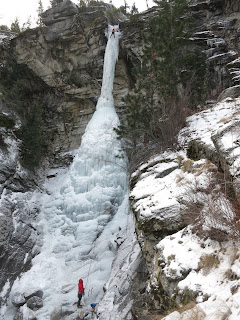As usual, fall has provided a great mix of climbing
 opportunities in Leavenworth and around the northwest, with everything from excellent roped rock climbing to bouldering and skiing along with waterfall ice. I took a quick visit to the sandstone and limestone of Mt. Charleston and Red Rock, NV, doing some short sport climbing, a 4-person party ascent of Epinephrine, and a ego-deflating non send of Texas Tower Direct. I also made a few short trips to central Oregon, where the amazing walls of Trout Creek and Smith Rock beckoned. At the American Alpine Club Craggin' Classic, I teamed up with Ben Rueck for the 10-hour "Crushfest" climbing competition. We came in second place, having onsighted and redpointed 67 pitches along the front side at Smith, an even mix of sport and trad routes.
opportunities in Leavenworth and around the northwest, with everything from excellent roped rock climbing to bouldering and skiing along with waterfall ice. I took a quick visit to the sandstone and limestone of Mt. Charleston and Red Rock, NV, doing some short sport climbing, a 4-person party ascent of Epinephrine, and a ego-deflating non send of Texas Tower Direct. I also made a few short trips to central Oregon, where the amazing walls of Trout Creek and Smith Rock beckoned. At the American Alpine Club Craggin' Classic, I teamed up with Ben Rueck for the 10-hour "Crushfest" climbing competition. We came in second place, having onsighted and redpointed 67 pitches along the front side at Smith, an even mix of sport and trad routes.At Trout Creek I "succeeded" in linking all the moves and cleanly TRing the open project left of Gateway. This line is going to be the hardest thing yet at the wall, with a couple boulder problems requiring some serious power and steel finger tips. It will be well protected with small cams and RPs. Trout's at-one-point hardest route, May Fly, put up by my friend Cody Scarpella and repeated by Tommy Caldwell, was repeated this fall by myself, Max Tepfer, and impressively flashed by Mikey Schaefer. It takes a narrowing 5.11/5.12 finger crack which ends at the same height that a nearby finger crack begins, requiring a ~V4 crux and amazing lower 5.11 climbing to the chains. Check out Cody working (and whipping) before the FA (starts at 3:40).
An hour west across the pass from Leavenworth, in Index, a couple days of climbing and working out beta with Jens Holsten and Ben Gilkison resulted in redpointing Narrow Arrow Direct, a gymnastic 5.12c pitch with the crux just below the ledge atop the pitch. I'd like to send every pitch on the "Narrow Arrow" by next spring, and now I've done the two (by far) most difficult lines.
The bouldering this fall was also excellent, with many pleasant, dry, but mid-temperature sunny days. I continued to fall off what might be the closest boulder problem to my house, "Fridge Left" (V8). But I did manage to complete the classic "WAS" (V8) on my first visit to the problem with a big rowdy crew of locals.
Late fall saw a big early snowfall and then a prolonged clear cold snap. I teamed up with old buddy Kurt Hicks and his friend Dustin to climb the rarely-in-condition Drury Falls above Leavenworth. Drury is one of the iconic ice climbs of the northwest, with an often-dangerous approach, a mandatory river crossing, and a little less than 1,000' of water ice. The early cold stretch with low snow made the approach perfect, and we avoided the sketchy rapids and pre-dawn boat shenanigans by simply rowing across Lake Jolanda below the whitewater, then hiking the opposite bank. The descent is generally mellow and made via tree rappels to the left of the route.
 |
| There are 2 ~55m approach pitches below, out of view. |
 Finally, I headed out to the Entiat Valley for some obscure local ice with Chad "(peak)crusher" Kellogg and Jens "(grape)crusher" Holsten. There are AT LEAST twice as many major flows which form up during a cold snap than you would expect from the guidebook. Jens sent the WI5 column "What do Ardenvoirs Eat?" and we then ramblied up the CLASSIC second pitch (much easier). To end the day Chad and I lead the 2-pitch "Tyee Falls" - which was similar to climbing slushy snice beneath the gutter of a house, the only difference being that one could not simply traverse or move out from beneath this gutter, because it was the entire route (except the classy cave belay).
Finally, I headed out to the Entiat Valley for some obscure local ice with Chad "(peak)crusher" Kellogg and Jens "(grape)crusher" Holsten. There are AT LEAST twice as many major flows which form up during a cold snap than you would expect from the guidebook. Jens sent the WI5 column "What do Ardenvoirs Eat?" and we then ramblied up the CLASSIC second pitch (much easier). To end the day Chad and I lead the 2-pitch "Tyee Falls" - which was similar to climbing slushy snice beneath the gutter of a house, the only difference being that one could not simply traverse or move out from beneath this gutter, because it was the entire route (except the classy cave belay).











































